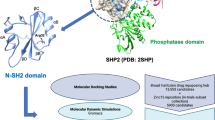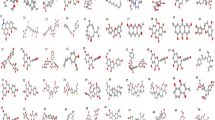Abstract
Polo like kinase-1 (PLK-1) is essential during mitosis and in the maintenance of genomic stability. Thus, PLK-1 can be a preferential target for inhibition of mitotic processing and hence can be chosen as a drug target for the treatment of cancer. The aim of the study was to develop and validate a pharmacophore model for PLK-1 inhibitors, which is able to reproduce the receptor bound conformation of the ligand as closely as possible. Out of 14 models which could reproduce the receptor-bound conformation of the ligand, two models performed well in the decoy set statistics. Final selection of the pharmacophore model was based upon the ability of the validated model to identify actives belonging to diverse chemical classes. The selected five-point pharmacophore model for a pyrazoloquinazoline class of PLK-1 inhibitors includes one hydrogen-bond donor (D), two hydrophobic features (H), one positively-charged feature (P), and one aromatic ring feature (R).




Similar content being viewed by others
References
Beria I, Ballinari D et al. (2010) Identification of 4, 5-dihydro-1H-pyrazolo [4, 3-h] quinazoline derivatives as a new class of orally and selective polo-like kinase 1 inhibitors. J Med Chem 53(9):3532–3551
Beria I, Bossi RT et al. (2011) NMS-P937, a 4, 5-dihydro-1H-pyrazolo [4, 3-h] quinazoline derivative as potent and selective Polo-like kinase 1 inhibitor. Bioorg Med Chem Lett 21(10):2969–2974
Beria I, Valsasina B et al. (2010) 4, 5-Dihydro-1H-pyrazolo [4, 3-h] quinazolines as potent and selective Polo-like kinase 1 (PLK-1) inhibitors. Bioorg Med Chem Lett 20(22):6489–6494
Braga RC, Andrade CH (2013) Assessing the performance of 3D pharmacophore models in virtual screening: how good are they? Curr Top Med Chem 13(9):1127–1138
Caruso M, Valsasina B et al. (2012) 5-(2-Amino-pyrimidin-4-yl)-1H-pyrrole and 2-(2-amino-pyrimidin-4-yl)-1, 5, 6, 7-tetrahydro-pyrrolo [3, 2-c] pyridin-4-one derivatives as new classes of selective and orally available polo-like kinase 1 inhibitors. Bioorg Med Chem Lett 22(1):96–101
Chekkara R, Kandakatla N, Gorla VR, Tenkayala SR, Susithra E (2017) Theoretical studies on benzimidazole and imidazo [1, 2-a] pyridine derivatives as polo-like kinase 1 (PLK-1) inhibitors: pharmacophore modeling, atom-based 3D-QSAR and molecular docking approach. J Saudi Chem Soc 21(1): S311–S321
Chen S, Bartkovitz D et al. (2012) Identification of novel, potent and selective inhibitors of polo-like kinase 1. Bioorg Med Chem Lett 22(2):1247–1250
Cheng KY, Lowe ED, Sinclair J, Nigg EA, Johnson LN (2003) The crystal structure of the human polo-like kinase-1 polo box domain and its phospho-peptide complex. EMBO J 22(21):5757–5768
Cheung M, Kuntz KW et al. (2008) Imidazo [5, 1-f][1, 2, 4] triazin-2-amines as novel inhibitors of polo-like kinase 1. Bioorg Med Chem Lett 18(23):6214–6217
Dietzmann K, Kirches E, Von Bossanyi P, Jachau K, Mawrin C (2001) Increased human polo-like kinase-1 expression in gliomas. J Neuro-Oncol 53(1):1–11
Dixon SL, Smondyrev AM et al. (2006) PHASE: a new engine for pharmacophore perception, 3D QSAR model development, and 3D database screening: 1. Methodology and preliminary results. J Comput Aided Mol Des 20(10-11):647–671
Dror O, Schneidman-Duhovny D, Inbar Y, Nussinov R, Wolfson HJ (2009) Novel approach for efficient pharmacophore-based virtual screening: method and applications. J Chem Inf Model 49(10):2333–2343
Drwal MN, Griffith R (2013) Combination of ligand- and structure-based methods in virtual screening. Drug Discov Today 10(3):e395–e401
Duffey MO, Vos TJ et al. (2011) Discovery of a potent and orally bioavailable benzolactam-derived inhibitor of polo-like kinase 1 (MLN0905). J Med Chem 55(1):197–208
Emmitte KA, Andrews CW et al. (2009) Discovery of thiophene inhibitors of polo-like kinase. Bioorg Med Chem Lett 19(3):1018–1021
Fucini RV, Hanan EJ et al. (2008) Design and synthesis of 2-amino-pyrazolopyridines as polo-like kinase 1 inhibitors. Bioorg Med Chem Lett 18(20):5648–5652
Gaurav A, Gautam V (2014) Structure-based three-dimensional pharmacophores as an alternative to traditional methodologies. J Recept Ligand Channel Res (7):27–38
Glover DM, Hagan IM, Tavares ÃlAM (1998) Polo-like kinases: a team that plays throughout mitosis. Genes Dev 12(24):3777–3787
Gray PJ, Bearss DJ et al. (2004) Identification of human polo-like kinase 1 as a potential therapeutic target in pancreatic cancer. Mol Cancer Ther 3(5):641–646
Hamanaka R, Smith MR et al. (1995) Polo-like kinase is a cell cycle-regulated kinase activated during mitosis. J Biol Chem 270(36):21086–21091
Hanan EJ, Fucini RV et al. (2008) Design and synthesis of 2-amino-isoxazolopyridines as polo-like kinase inhibitors. Bioorg Med Chem Lett 18(19):5186–5189
He L, Zhou L, Wang T, Li Z, Tang X (2013) Identification of potent virtual leads to design novel PLK-1 inhibitors: pharmacophore modeling, virtual screening and molecular docking studies. Mol Simul 39(8):640–652
Joshi AJ, Gadhwal MK, Joshi UJ (2014) A combined approach based on 3D pharmacophore and docking for identification of new aurora A kinase inhibitors. Med Chem Res 23(3):1414–1436
Kirchmair J, Markt P, Distinto S, Wolber G, Langer T (2008) Evaluation of the performance of 3D virtual screening protocols: RMSD comparisons, enrichment assessments, and decoy selection—What can we learn from earlier mistakes? J Comput Aided Mol Des 22(3–4):213–228
Knecht R, Elez R et al. (1999) Prognostic significance of polo-like kinase (PLK) expression in squamous cell carcinomas of the head and neck. Cancer Res 59(12):2794–2797
Kothe M, Kohls D et al. (2007) Structure of the catalytic domain of human polo-like kinase 1. Biochemistry 46(20):5960–5971
Lee HS, Choi J et al. (2008) Optimization of high throughput virtual screening by combining shape-matching and docking methods. J Chem Inf Model 48(3):489–497
Nigg EA (1998) Polo-like kinases: positive regulators of cell division from start to finish. Curr Opin Cell Biol 10(6):776–783
Sanders MPA, Barbosa AnJM et al. (2012) Comparative analysis of pharmacophore screening tools. J Chem Inf Model 52(6):1607–1620
Sato Y, Onozaki Y et al. (2009) Imidazopyridine derivatives as potent and selective polo-like kinase (PLK) inhibitors. Bioorg Med Chem Lett 19(16):4673–4678
Takai N, Miyazaki T et al. (2001) Expression of polo-like kinase in ovarian cancer is associated with histological grade and clinical stage. Cancer Lett 164(1):41–49
Wang H-Y, Cao Z-X et al. (2008) Pharmacophore modeling and virtual screening for designing potential PLK-1 inhibitors. Bioorg Med Chem Lett 18(18):4972–4977
Weichert W, Schmidt M et al. (2004) Polo-like kinase 1 is overexpressed in prostate cancer and linked to higher tumor grades. The Prostate 60(3):240–245
Wermuth C-G, Ganellin CR, Lindberg P, Mitscher LA (1998) Glossary of terms used in medicinal chemistry (IUPAC Recommendations 1997). Annu Rep Med Chem 33:385–395
Wolf G, Elez R et al. (1997) Prognostic significance of polo-like kinase (PLK) expression in non-small cell lung cancer. Oncogene 14(5):543–549
Wolf G, Hildenbrand R et al. (2000) Polo-like kinase: a novel marker of proliferation: correlation with estrogen-receptor expression in human breast cancer. Pathol Res Pract 196(11):753–759
Acknowledgements
The authors sincerely acknowledge DBT (BT/PR14373/MED/30/530/2010) for funding received.
Author information
Authors and Affiliations
Corresponding author
Ethics declarations
Conflict of interest
The authors declare that they have no competing interests.
Rights and permissions
About this article
Cite this article
Joshi, A.J., Bhojwani, H.R. & Joshi, U.J. Strategies to select the best pharmacophore model: a case study in pyrazoloquinazoline class of PLK-1 inhibitors. Med Chem Res 27, 234–260 (2018). https://doi.org/10.1007/s00044-017-2057-9
Received:
Accepted:
Published:
Issue Date:
DOI: https://doi.org/10.1007/s00044-017-2057-9




